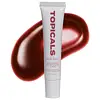What's inside
What's inside
 Key Ingredients
Key Ingredients

 Benefits
Benefits

 Concerns
Concerns

 Ingredients Side-by-side
Ingredients Side-by-side

Tridecyl Trimellitate
EmollientOctyldodecanol
EmollientPolyisobutene
Polyglyceryl-3 Diisostearate
EmulsifyingCandelilla Cera
EmollientCopernicia Cerifera Cera
EmollientBehenyl Behenate
EmollientPolyhydroxystearic Acid
EmulsifyingMentha Arvensis Leaf Oil
MaskingPersea Gratissima Oil
Skin ConditioningButyrospermum Parkii Butter
Skin ConditioningHelianthus Annuus Seed Oil
EmollientSimmondsia Chinensis Seed Oil
EmollientPlukenetia Volubilis Seed Oil
EmollientRicinus Communis Seed Oil
MaskingSodium Hyaluronate
HumectantHydrogenated Castor Oil
EmollientPentaerythrityl Tetra-Di-T-Butyl Hydroxyhydrocinnamate
AntioxidantTocopheryl Acetate
AntioxidantEthylhexyl Palmitate
EmollientTribehenin
EmollientSorbitan Isostearate
EmulsifyingLactic Acid
BufferingPalmitoyl Tripeptide-1
Skin ConditioningTocopherol
AntioxidantPhenoxyethanol
PreservativeLimonene
PerfumingTridecyl Trimellitate, Octyldodecanol, Polyisobutene, Polyglyceryl-3 Diisostearate, Candelilla Cera, Copernicia Cerifera Cera, Behenyl Behenate, Polyhydroxystearic Acid, Mentha Arvensis Leaf Oil, Persea Gratissima Oil, Butyrospermum Parkii Butter, Helianthus Annuus Seed Oil, Simmondsia Chinensis Seed Oil, Plukenetia Volubilis Seed Oil, Ricinus Communis Seed Oil, Sodium Hyaluronate, Hydrogenated Castor Oil, Pentaerythrityl Tetra-Di-T-Butyl Hydroxyhydrocinnamate, Tocopheryl Acetate, Ethylhexyl Palmitate, Tribehenin, Sorbitan Isostearate, Lactic Acid, Palmitoyl Tripeptide-1, Tocopherol, Phenoxyethanol, Limonene
Hydrogenated Polyisobutene
EmollientPolybutene
Jojoba Esters
EmollientCocos Nucifera Oil
MaskingHelianthus Annuus Seed Oil
EmollientEthylene/Propylene/Styrene Copolymer
Copernicia Cerifera Wax
Butylene/Ethylene/Styrene Copolymer
Glycerin
HumectantSodium Hyaluronate
HumectantHydrolyzed Sodium Hyaluronate
Skin ConditioningCeramide NP
Skin ConditioningCeramide AP
Skin ConditioningCeramide EOP
Skin ConditioningPhytosphingosine
Skin ConditioningPalmitoyl Tripeptide-38
Skin ConditioningCholesterol
EmollientTocopheryl Acetate
AntioxidantErgothioneine
AntioxidantStevia Rebaudiana Leaf/Stem Powder
Skin ConditioningPortulaca Pilosa Extract
Skin ConditioningSucrose Cocoate
EmulsifyingPanthenol
Skin ConditioningSodium Lauroyl Lactylate
EmulsifyingSilica
AbrasiveCarbomer
Emulsion StabilisingKaolin
AbrasiveOryza Sativa Bran Wax
Skin ConditioningXanthan Gum
EmulsifyingDimer Dilinoleyl Dimer Dilinoleate
EmollientTriisostearin
Skin ConditioningCetearyl Ethylhexanoate
EmollientOctyldodecanol
EmollientSorbitan Isostearate
EmulsifyingSorbitan Oleate
EmulsifyingWater
Skin ConditioningAroma
CI 77742
Cosmetic ColorantCI 17200
Cosmetic ColorantCI 45380
Cosmetic ColorantCI 77491
Cosmetic ColorantCI 77499
Cosmetic ColorantCI 77891
Cosmetic ColorantHydrogenated Polyisobutene, Polybutene, Jojoba Esters, Cocos Nucifera Oil, Helianthus Annuus Seed Oil, Ethylene/Propylene/Styrene Copolymer, Copernicia Cerifera Wax, Butylene/Ethylene/Styrene Copolymer, Glycerin, Sodium Hyaluronate, Hydrolyzed Sodium Hyaluronate, Ceramide NP, Ceramide AP, Ceramide EOP, Phytosphingosine, Palmitoyl Tripeptide-38, Cholesterol, Tocopheryl Acetate, Ergothioneine, Stevia Rebaudiana Leaf/Stem Powder, Portulaca Pilosa Extract, Sucrose Cocoate, Panthenol, Sodium Lauroyl Lactylate, Silica, Carbomer, Kaolin, Oryza Sativa Bran Wax, Xanthan Gum, Dimer Dilinoleyl Dimer Dilinoleate, Triisostearin, Cetearyl Ethylhexanoate, Octyldodecanol, Sorbitan Isostearate, Sorbitan Oleate, Water, Aroma, CI 77742, CI 17200, CI 45380, CI 77491, CI 77499, CI 77891
 Reviews
Reviews

Ingredients Explained
These ingredients are found in both products.
Ingredients higher up in an ingredient list are typically present in a larger amount.
Helianthus Annuus Seed Oil is the oil derived from the seeds of a Sunflower. Sunflower seed oil is non-fragrant. It is an emollient, meaning it helps to soften the skin.
Sunflower seed oil contains many fatty acids. The fatty acids found in sunflower seeds include (from highest amount to least): linoleic acid, myristic acid, palmitic acid, stearic acid, arachidic acid, oleic acid, and linolenic acid.
These fatty acids help the skin create ceramides. Ceramides play a role in repairing the skin barrier.
Helianthus Annuus Seed Oil helps moisturize the skin. This in turn helps the skin look more rejuvenated and smoother.
Sunflowers are rich in vitamin E.
Historians believe Indigenous cultures of North America domesticated sunflowers before corn. Thus they relied on sunflower oil for a variety of uses. One such use is moisturizing skin and hair.
Sunflower seed oil may not be fungal acne safe. We recommend speaking with a professional if you have any concerns.
Learn more about Helianthus Annuus Seed OilOctyldodecanol is a fatty alcohol. It is primarily used to enhance the texture of products.
As an emulsifier, Octyldodecanol helps prevent the oils and waters from separating. It also prevents ingredients from creating foam when shaken.
Octyldodecanol is created by reducing fatty acid to an alcohol.
Due to its high molecular weight, it does not get absorbed into the skin.
Learn more about OctyldodecanolSodium Hyaluronate is hyaluronic acid's salt form. It is commonly derived from the sodium salt of hyaluronic acid.
Like hyaluronic acid, it is great at holding water and acts as a humectant. This makes it a great skin hydrating ingredient.
Sodium Hyaluronate is naturally occurring in our bodies and is mostly found in eye fluid and joints.
These are some other common types of Hyaluronic Acid:
Learn more about Sodium HyaluronateSorbitan Isostearate is an emulsifer and cleaning agent. It is created from isostearic acid and sorbitol.
As an emulsifier, Sorbitan Isostearate prevents oils and water from separating.
Due to its isostearic acid base, it may not be safe for Malassezia or fungal acne.
Learn more about Sorbitan IsostearateTocopheryl Acetate is AKA Vitamin E. It is an antioxidant and protects your skin from free radicals. Free radicals damage the skin by breaking down collagen.
One study found using Tocopheryl Acetate with Vitamin C decreased the number of sunburned cells.
Tocopheryl Acetate is commonly found in both skincare and dietary supplements.
Learn more about Tocopheryl Acetate